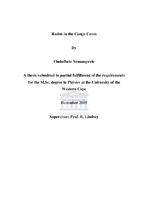Radon in the Cango Caves
Abstract
Radon is a naturally occurring radioactive element in the 238U decay series that is found in high concentrations in certain geological formations such as Caves. Exposure to high concentrations of radon has been positively linked to the incidence of lung cancer. This study used Electret ion chambers and the RAD7 continuous radon monitor to measure radon concentrations in the Cango Caves in the Western Cape Province, South Africa. Measurements were taken during summer i.e. February 2004 and March 2005. The results for the radon activity concentrations range from the minimum of about 800 Bq.m-3 to a maximum of 2600 Bq.m-3. The two techniques give very similar results, though the Electret ion chamber results appear to be consistently higher by a few percent where measurements were taken at the same locations. A mathematical model has been developed to investigate the radon concentrations in the Cave. Diffusion and ventilation have been considered as mechanisms for explaining the distribution of radon concentrations. The ventilation rate in the Cave has been estimated under certain assumptions, and it is found to be about 7 ×10−6 s−1 for the Van Zyl hall which is the first large chamber in the Cave. The radon concentration increases as one goes deeper into the Cave, but then becomes fairly constant for the deeper parts. The annual effective dose that the guides are exposed to in the Cave as a result of the radon concentrations, depends strongly on the time that they spend in the Cave and in which, halls they spend most of their time in the Cave. The initial results indicate an annual effective dose of 4-10 mSv, but this needs to be further investigated.

